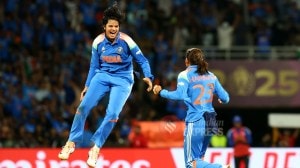Family Footage
KANIMOZHI had always shunned politics, particularly the arc lights that accompanied it. She silently observed as her father, M Karunanidhi, ...

KANIMOZHI had always shunned politics, particularly the arc lights that accompanied it. She silently observed as her father, M Karunanidhi, drew up strategies or chaired hushed meetings in the family drawing room.
But the daughter’s secret admiration for her father’s abiding stature in Tamil Nadu politics and his literary acumen (which spearheaded a new path in contemporary Tamil literature) spurred her on to the project of her lifetime—a political documentary on the 82-year-old patriarch of the Dravida Munnetra Kazhagam. It’s the first time that the life of an Indian political figure is being documented on film by his or her offspring.
A few years ago, Kanimozhi happened to watch a documentary on her father. ‘‘I don’t remember who made it, but it was a disaster, and I felt that he deserved better,’’ she says. Kanimozhi, who has inherited Karunanidhi’s poetic genes, keenly followed her father’s works—be it his scripts soaked in Dravidian propaganda or his other writings.
She called her friend, Alphonse Roy, an award-winning wildlife photographer and videographer, and the project kicked off. ‘‘Roy has a passion for Dravidian politics. I wanted to team up with someone who would instinctively move along with my project.’’ She got more than a willing and apt candidate in Roy.
During the run-up to the 2004 Lok Sabha elections in May, Kanimozhi and Roy filmed the first footage on their yet untitled two-hour documentary. On the Island Grounds in Chennai, Karunanidhi shared a platform with Sonia Gandhi and other allies of the United Progressive Alliance. The meeting was also historical because the DMK and the Congress had come together for the first time in 24 years.
| Power trip M KARUNANIDHI started as a scriptwriter for Modern Theatres, Chennai. He gained acclaim first with Parasakthi (1952), a Tamil film in which Sivaji Ganesan made his debut. The leaders of the Dravidian movement used theatre and cinema to gain political power, creating the phenomenon of star politicians like the late matinee idol and founder of the AIADMK, MG Ramachandran, who thrived on dialogues written by Karunanidhi. DMK was launched as a political party in 1949 and Karunanidhi was one of its leading ideologues, using the characters in films such as Parasakthi as mouthpieces for his rationalist ideas. While Karunanidhi’s political career showed early promise, his rivalry with MGR proved disastrous. He became the Chief Minister of Tamil Nadu for the first time in 1969, after which his career was a see-saw until 1996, when he took over as chief minister and served a full term until 2001 |
‘‘Leaving out events from his life was more difficult because so much has happened and so much is happening,’’ admits Kanimozhi, relaxing at her Chennai home. When she is not writing poetry, the soft-spoken 37-year-old takes part in literary and social debates. The only child of Rajathiammal, Karunanidhi’s second wife, Kanimozhi is close to Karunanidhi’s first wife, whom she refers to as dayalamma. She is known as Karunanidhi’s favourite daughter although the patriarch has made no attempts to initiate her into politics against her wishes.
Kanimozhi says that her father has always spared quality time for her—keenly following her literary works and discussing them with her.
Since Kanimozhi has stayed away from her father’s political persona, she and Roy had to acquire long archival footage, which may not make it to the final version of the film—‘‘We intend to preserve these clips in a library because they are rich in history.’’ Besides interviews with well-known Tamil journalists like Chinna Kuthoosi, who also doubled as a chronicler and interpreter of Tamil Nadu’s political history, the duo also threw in views of Tuglak editor Cho Ramasamy, who has been a bitter critic of Karunanidhi. ‘‘I spoke to people who had observed him closely, and it has been quite an experience learning about the ways people look at him,’’ says Kanimozhi. But the interview that she cherishes the most is with VP Singh—‘‘It was a warm and emotional interview because his association with my dad goes back a long way.’’
The most satisfying part of the filming has been Kanimozhi’s own interactions with her father. ‘‘I had to understand his life like I had never before,’’ she says, recalling the high points during the 12-odd hours of shooting spread over three days. ‘‘He shared his views on development, his relationships and his memories of Sivaji Ganesan, who he deeply admired as an actor.’’
Karunanidhi also spoke to his daughter at length about the most crucial phases of his political career, especially the unsuccessful attempt by former Orissa chief minister Biju Patnaik at a patch-up between him and MGR, his friend-turned-rival, in the early ’80s. ‘‘My father’s mind is still sharp and clear,’’ says Kanimozhi, her tone betraying her admiration. ‘‘We spoke to a lot of people connected to my father, capturing not just their memories, but interpretations of him.’’
Kanimozhi’s take on her father’s life is focused on what pushes her father at this age—politics, people and literature. She hopes to have the film ready by early next year—a gift, which both the father and daughter would treasure.


- 01
- 02
- 03
- 04
- 05





























